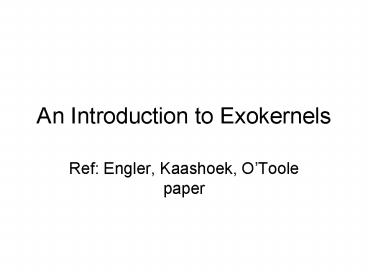An Introduction to Exokernels - PowerPoint PPT Presentation
1 / 9
Title:
An Introduction to Exokernels
Description:
Thin exokernel veneer exports resources to library OS (application) through secure bindings ... Authorization to use resource only done at bind time ... – PowerPoint PPT presentation
Number of Views:60
Avg rating:3.0/5.0
Title: An Introduction to Exokernels
1
An Introduction to Exokernels
- Ref Engler, Kaashoek, OToole paper
2
Basic Premise
- OS builds abstractions (processes, files, address
spaces, IPC) to hide applications from low-level
information about machine resources - This is a bad thing!
- Applications cannot use knowledge about the
application to optimize performance (e.g., memory
access patterns) - Applications cannot easily change implementations
of the OS abstractions, e.g., to optimize
performance - Restricts flexibility of application builders
because new abstractions can only be built on top
of existing ones (if at all) - Solution Application level (i.e., untrusted)
resource management - Exokernel abstractions such as VM, IPC
implemented at application level - Philosophy not unlike micro-kernels, but more
extreme, e.g., virtual memory and IPC implemented
in application rather than microkernel
3
Exokernel-Based System
Applications
Mosaic
Barnes-Hut
WWW
DSM
POSIX
TCP
VM
IPC
Library OS
traps
Secure bindings
Exokernel
Frame buffer
TLB
Network
Memory
Disk
Hardware
- Thin exokernel veneer exports resources to
library OS (application) through secure bindings - Multiplex usage of resources tables track
ownership - Each library OS implements its own system objects
and policies - Applications link against standard libraries,
e.g., - WWW, POSIX, TCP for web applications
- Shared memory abstractions for parallel
applications
4
Exokernel Design Principles
- Securely expose hardware
- Examples priveleged instructions, hardware DMA,
resources such as physical memory, CPU, disk,
TLB, address content identifiers, interrupts - Each exported operation wrapped in a system call
that checks ownership - Exokernel does not manage resources
- Expose allocation
- For example, Library OS can request specific
physical pages to reduce cache conflicts - Expose names
- For example, physical page numbers
- Expose revocation
- Visible resource revocation protocol to manage
resources among Library OSes - Resource policy decisions given to Library OSes
5
Exokernel Design
- Main challenge give library OS freedom to manage
physical resources while protecting them from
each other - Track ownership of resources
- Guard resource usage or binding points
- Revoke access to resources
- Three techniques
- Secure bindings of applications to machine
resources - Visible resource revocation applications
participate in resource revocation protocol - Abort protocol to break secure bindings to
uncooperative applications
6
Secure Bindings
- Multiplex resources securely among Library OSes
- Authorization to use resource only done at bind
time - Simple, fast, protection check done when resource
is accessed - Example multiplexing physical memory
- Hardware support
- Allocate physical page bind page, recording
owner and read/write capability specified by
library OS - TLB hit accesses checked by hardware
- TLB miss virtual to physical translation done in
library OS, loaded in kernel capabilities
checked - Break secure binding Flush TLB mappings
- Software caching
- Store virtual-to-physical translations in large
software TLB cache to improve performance - cache
of frequently used secure bindings
7
Visible Resource Revocation
- Traditional OSes revoke resources w/o application
involvement (e.g., deallocating physical memory) - Application cannot guide deallocation (e.g.,
which page?) is not informed resource is scarce - Exokernel uses visible revocation of resources
- For example, when giving up CPU, need not save
(say) floating point registers if Library OS
knows registers are not being used
8
Abort Protocol
- Some library OSes might not respond
satisfactorily to revocation requests (e.g., give
up memory) - Kernel can revoke resource and break secure
bindings by force - Library OS receives repossession exception to
indicate resource has been removed
9
Summary
- Argue OS abstractions are bad for applications
- Traditional OS abstractions implemented in
Library OS, at application level - Idea securely export hardware resources without
abstraction - Measurements indicate substantial performance
benefit using this approach - primitive kernel
operations 10x to 100x faster than Ultrix - Some issues to ponder
- Potential for many different Library OSes!
Assume far more application developers than
hackers - Portability?
- Security?































